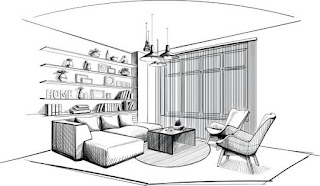Interior design degree courses in chennai - Aleesha Institute
This paper analyzes the use of Augmented Reality technology and Augmented Reality 3D interior model for interior design. According to the feature of interior design, the best way to share the concept of an interior design project to customer in the conceptual design stage is to perform it in a vivid 3D prototype. The traditional 3D interior space prototypes are created by designers and evaluated by customers, but we want to expand the affection of customersಬ requirements in the conceptual design. The designer and customer establish a 3D interior space model together in conceptual design stage by first creating 3D interior structure model, followed by choosing hard-soft decoration method and customized decoration requirements in an Augmented Reality Interior Design System. A hard decoration modeling framework is built for design project improvement and evaluation to guarantee that user can coordinate every aspect of the design project to achieve a balance between structure and function. The augmented content and sensory information of decorative material-furniture-appliance for soft decoration can be simulated with special stereoscopic equipments as an AR3D interior prototype in ARID system to enhance the understanding and participation of customers in the customized interior design project. http://www.aleeshainstitute.com/interior-designing-course.php This paper discusses the possibility of Augmented Reality Technology applied to the interior design and construction process. According to Ivan Sutherlandಬs paper ಯThe Ultimate Displayರ(1), he defines the term ಫVirtual Realityಬas a system used to display information to all senses of a person without this physical environment. The VR is usually used to define Simulation, Interaction, Artificiality, Immersion, Telepresence, Full-body Immersion, and network communication. In current scenario, the definition of VR has been changed and expanded, used to explain a notion which is between the virtual world and physical world so-called Augmented Reality (AR).The Augmented Reality is described in Fig.1. The various category of space, material, furniture, and other related facilities in different kind of interior design and the consumerಬs high demand for participate in the designing process for achieve their individual style, increases the interior design and its designers require for information and interaction technologies. In recent interior design, the primary focus for interior designers and consumers is the ability to compositions of real and virtual information (include the objects, materials, and scenes) and flexible interactive in an augmented reality model. The augmented reality technology is fit for this purpose. AR can provide a vivid view (direct or indirect view) of the physical world where elements are enhanced by computer-generated files such as video, graphics, sound, images, or other kind of digital data. This technology is applied to allow a person (the designer, the manufacturer, and the consumer) to combine real and virtual information and objects in a physical, realworld environment. In contrast, VR technology still focuses on establish a simulated environment based on the real world by computer. Designer implemented VR techniques for the designing processes and the virtual prototyping, which can only provide the information and appearance of the virtual scenes for designer and consumer.
This paperಬs target is to analyze and evaluate the impact
of Augmented Reality Technology in interior design. The
research context is associated at the consumerಬs perception
of the project in the management and execution of the
interior design. Finally, we provide a design framework
which shows that the augmented reality technology is the
way of interior design future so that the cooperation of
designers and consumer would be convenient and efficient.

Comments
Post a Comment